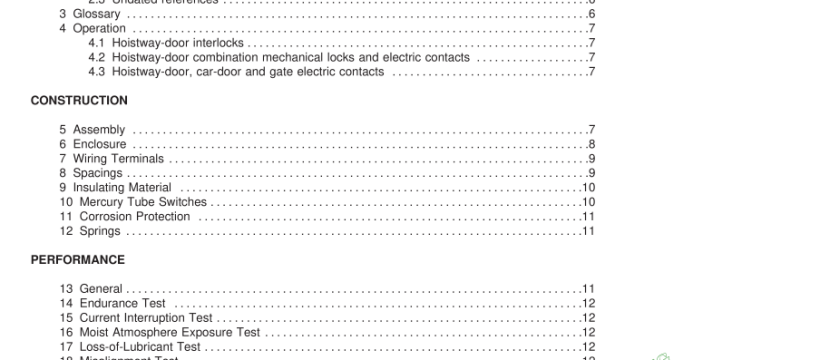UL 104-2007 pdf download.Elevator Door Locking Devices and Contacts.
4 Operation 4.1 Hoistway-door interlocks 4.1 .1 An interlock contact shall be positively opened by the locking member or by a member connected to and mechanically operated by the locking member. 4.1 .2 An interlock contact shall be maintained in the open position by the action of gravity or by a restrained compression spring, or by both, or by means of the opening member. 4.1 .3 An interlock shall hold the door in the locked position by means of gravity or by a restrained compression spring, or by both, or by means of a positive linkage. 4.1 .4 An interlock shall lock the door in the closed position before the interlock contacts close. 4.2 Hoistway-door combination mechanical locks and electric contacts 4.2.1 A hoistway-door combination mechanical lock and electric contact shall be designed so that the locking member and the electric contact are mounted on and attached to a common base in such a manner that there is a fixed relation between the location of the contact and the location of the locking member. They shall be designed so that when installed and adjusted in accordance with the manufacturer’s instructions: a) The electric contact cannot close until the door is in the closed position and b) The locking member is in a position to lock the door when or before the contact closes. In order to prevent motion of the door from opening the electric contact while the door is locked in the closed position, multiple-locking points shall, where necessary, be provided on the locking mechanism. 4.2.2 The electric contact shall be positively opened by the locking bar of the mechanical lock or by a lever or other device attached to and operated by the door. The contact shall be maintained in the open position by the action of gravity, a restrained compression spring, both, or by positive mechanical means. 4.2.3 The mechanical lock shall hold the door in the locked position by means of gravity, a restrained compression spring, or both.
6 Enclosure 6.1 The enclosure shall be constructed and assembled so that it will withstand handling during shipment and installation. 6.2 The enclosure and parts, such as covers, shall be provided with means for firmly securing them in place. 6.3 Bolts, screws, or other parts used for mounting the device shall be independent of those used for securing parts of the device to the frame, base, or enclosure. 6.4 A sheet metal enclosure shall not be less than 0.053 inch (1 .35 mm) thick. 6.5 A cast metal enclosure, whether iron or other metal, shall be at least 1 /8 inch (3.2 mm) thick at all points and of greater thickness at reinforcing ribs and door edges, and not less than 1 /4 inch (6.4 mm) thick at tapped holes for conduit. 6.6 The mechanical strength of a nonmetallic enclosure shall be at least equivalent to a sheet metal enclosure of the minimum thickness specified in 6.4. 6.7 Among the factors taken into consideration when evaluating the acceptability of a nonmetallic enclosure are: a) The mechanical strength; b) Resistance to impact; c) Moisture-absorption properties; d) Combustibility and resistance to ignition from electrical sources; e) Dielectric strength, insulation resistance, and resistance to arc tracking; and f) Resistance to distortion and creeping at temperatures to which the material may be subjected under conditions of normal or abnormal usage. All these factors are considered with respect to aging. 6.8 The enclosure and parts shall be arranged so that wiring connected to the device terminals would not be abraded by nor interfere with the operating parts of the device.
7 Wiring Terminals 7.1 The parts to which wiring connections are made may consist of clamps or wire-binding screws with cupped washers, terminal plates having upturned lugs, or the equivalent, to hold the wire in position. 7.2 A wire binding screw at a wiring terminal shall not be smaller than No. 8 (4.2 mm diameter). Exception: A No. 6 (3.5 mm diameter) screw may be used for the connection of one No. 1 4 AWG (2.1 mm 2 ), one No. 1 6 AWG (1 .3 mm 2 ), or one No. 1 8 AWG (0.82 mm 2 ) size wire. 7.3 The terminal plate for a wire-binding screw shall be of metal not less than 0.030 inch (0.76 mm) thick, and there shall not be less than two full threads in the metal. 7.4 A wire-binding screw shall not thread into material other than metal. 7.5 A wiring terminal shall be secured to its supporting surface by methods other than friction between surfaces so that it will be prevented from turning.UL 104-2007 pdf download.
UL 104-2007 pdf download
